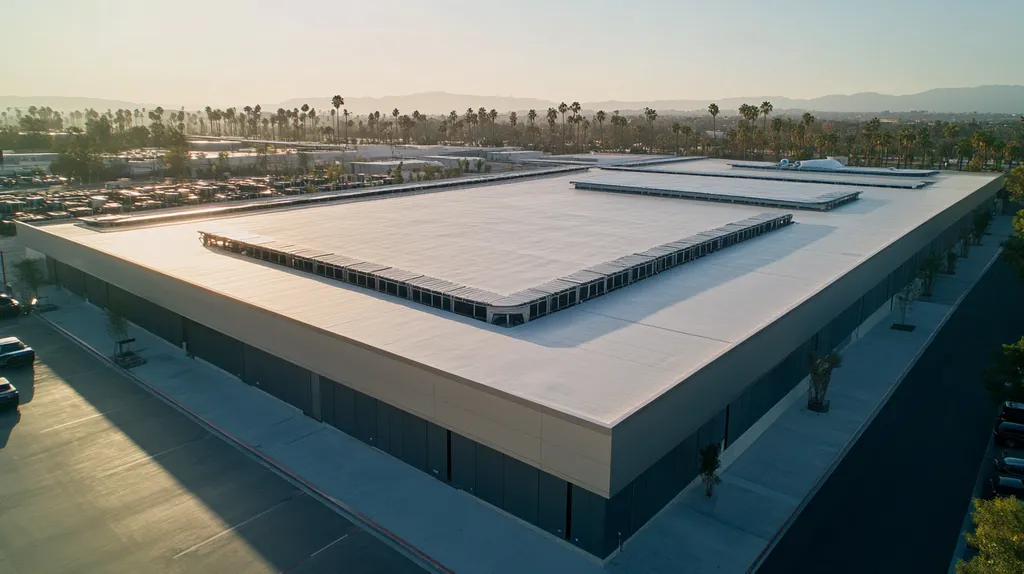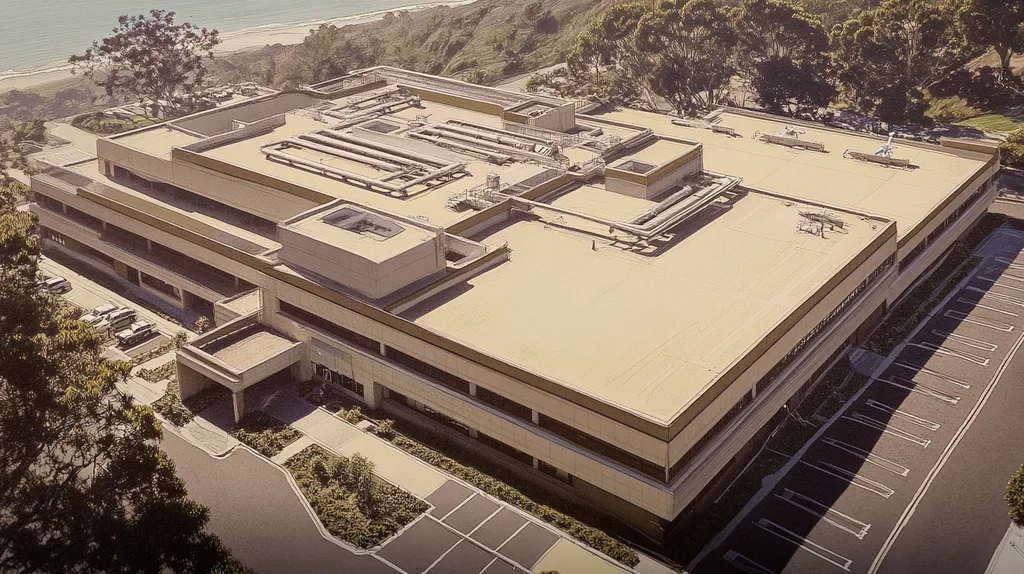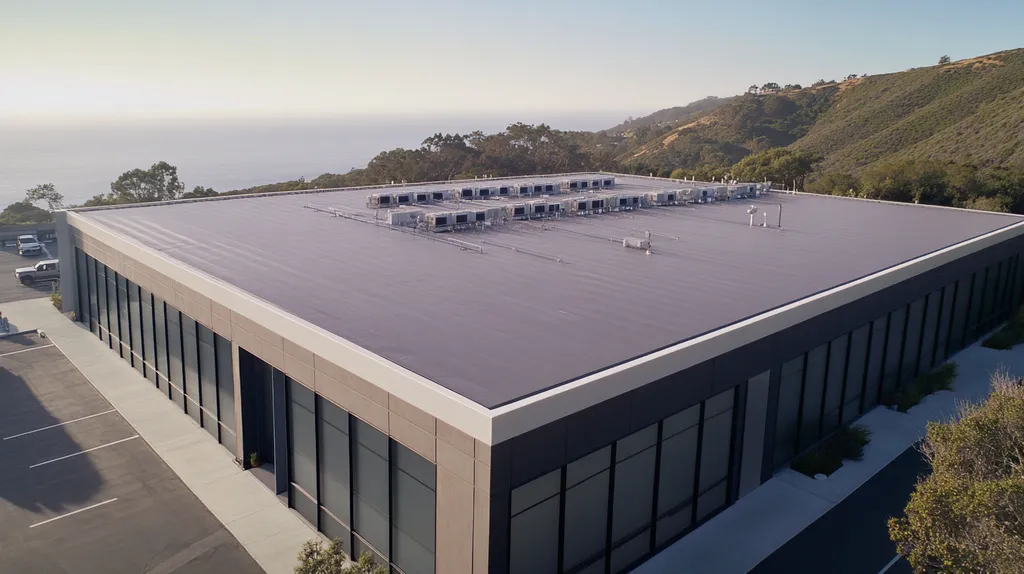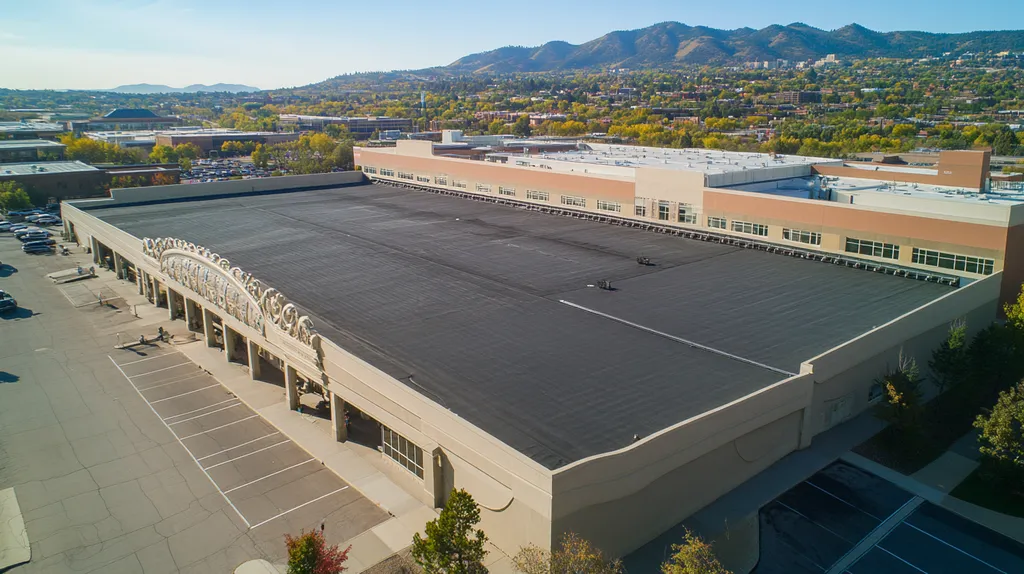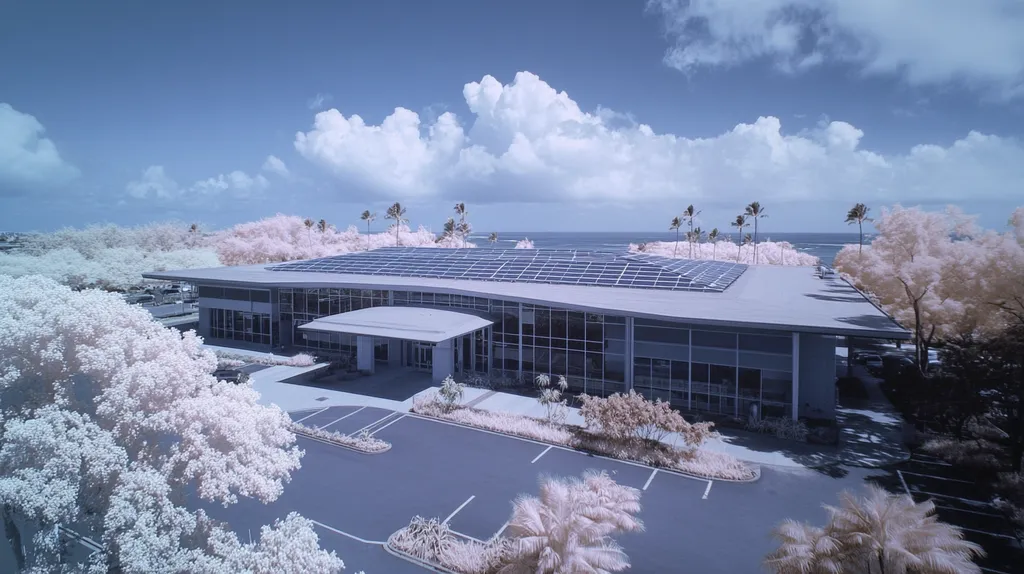Commercial buildings waste up to $30 billion annually through inefficient roofing systems, with energy losses accounting for 40% of total building operating costs.
Modern energy-efficient roofing technologies can slash these losses by 25-35% while extending roof lifespan by up to 15 years, transforming a building’s biggest energy drain into a performance asset.
This comprehensive guide examines the essential components, practical applications, and strategic implementation of energy-efficient roofing systems that drive commercial building success.
SECTION 1: THE BASICS EXPLAINED
Commercial roofing systems represent one of the largest energy drains in modern buildings, accounting for up to 40% of a facility’s total energy loss. As energy costs continue to surge, implementing efficient roofing solutions has become a critical business decision rather than a luxury upgrade. Modern energy-efficient systems can slash cooling costs by 25-35% while extending roof lifespan by up to 15 years, making them essential for competitive building operations.
What It Is (In Plain Language)
An energy-efficient roofing system combines advanced materials and design strategies to minimize heat transfer between your building and the outside environment. These systems act like a building’s “smart hat,” managing temperature and moisture intelligently.
The three primary categories include reflective systems that bounce away solar heat, insulative systems that block heat transfer, and hybrid solutions that combine both approaches. Modern installations often incorporate multiple layers working together.
Cool roof coatings use specialized pigments to reflect up to 80% of solar radiation, compared to traditional dark roofs that only reflect 20%. This dramatic difference directly impacts cooling requirements.
Advanced insulation materials create thermal barriers that work year-round, reducing both summer cooling and winter heating demands. These materials maintain their performance for decades with minimal maintenance.
Why It Matters (To Your Building)
The financial impact of energy-efficient roofing extends far beyond monthly utility bills. These systems typically reduce peak cooling demands by 15-25%, allowing for smaller HVAC equipment and lower maintenance costs.
Building value increases significantly with energy-efficient roofs. Properties with documented energy savings often command higher rents and sales prices, while meeting increasingly strict building codes and environmental regulations.
Occupant comfort improves dramatically when roof temperatures remain stable. This leads to fewer temperature complaints, more productive workers, and higher tenant satisfaction rates.
Energy-efficient roofs also protect building structures by reducing thermal stress and preventing moisture accumulation. This protection extends the life of both the roof system and the building components beneath it.
How It Works
Energy-efficient roofing systems employ multiple mechanisms to control heat flow. The outer layer reflects solar radiation before it can become heat, while inner layers trap and manage any heat that does penetrate.
Advanced materials create thermal breaks that prevent heat from moving through the roof structure. This process works like a thermal maze, forcing heat to take longer paths and dissipate before reaching the building interior.
Ventilation layers between roofing components allow heat to escape rather than build up. This continuous air movement prevents hot spots and helps maintain consistent temperatures across the entire roof surface.
Modern systems also adapt to changing conditions. They provide better insulation during cold weather while maximizing reflection during hot periods, ensuring year-round performance optimization.
Integration with building automation systems allows for real-time monitoring and adjustment of roof performance, ensuring maximum efficiency as conditions change throughout the day and seasons.
SECTION 2: PRACTICAL APPLICATIONS
The roofing decisions made today impact a building’s performance for decades to come. With commercial buildings losing up to 40% of their energy through poor roof performance, implementing energy-efficient systems has become a critical business imperative. Understanding where and how to apply these technologies can mean the difference between a building that drains resources and one that maximizes both comfort and cost savings.
Common Uses & Examples
Cool roofs represent one of the most widely adopted energy-efficient solutions, reducing roof surface temperatures by up to 50°F compared to conventional dark roofs. These systems extend roof material lifespan by minimizing thermal degradation while helping mitigate urban heat island effects in cities. (source: ENERGY STAR)
Large retail facilities and distribution centers frequently employ white or light-colored TPO membranes to reflect solar radiation. These installations have demonstrated cooling cost reductions of 15-30% in warm climates.
Manufacturing facilities often combine reflective coatings with enhanced insulation systems. This dual approach manages both external heat gain and internal heat production from equipment.
Healthcare facilities and data centers utilize multi-layer systems incorporating both cool roof technology and advanced thermal barriers. These critical facilities require precise temperature control to maintain operations.
When You Need It Most
Buildings with high cooling loads or significant internal heat generation benefit most from energy-efficient roofing. This includes facilities with extensive computer equipment, industrial processes, or large occupant loads.
Structures in urban heat islands or regions with extended cooling seasons see amplified benefits. The combination of ambient heat and reflected heat from surrounding buildings makes traditional roofing especially inefficient in these locations.
Aging facilities with outdated roofing systems present prime opportunities for energy-efficient upgrades. These buildings often suffer from deteriorated insulation and compromised vapor barriers.
Properties undergoing HVAC upgrades should coordinate with roof improvements. The reduced cooling load from an efficient roof can allow for smaller, less expensive mechanical systems.
Interactions With Other Systems
Energy-efficient roofing works in concert with building automation systems to optimize performance. Temperature sensors and smart controls can adjust internal systems based on roof performance data.
Proper ventilation design multiplies the benefits of energy-efficient roofing. Coordinated airflow management prevents heat buildup in critical spaces while maintaining appropriate pressure relationships.
Solar installations gain efficiency when paired with cool roofing systems. The reduced ambient temperature helps photovoltaic panels operate at peak performance levels.
Drainage systems require careful integration with energy-efficient roofing components. Proper water management prevents ponding that could compromise thermal performance while protecting the building envelope.
SECTION 3: KEY TERMINOLOGY DECODED
Commercial roofing terminology can make or break million-dollar decisions. When facility managers misinterpret specifications or confuse performance metrics, it leads to costly system failures and excessive energy waste. Studies show that up to 30% of roofing problems stem from miscommunication about technical requirements and performance expectations.
Essential Terms Explained
R-value measures how well insulation resists heat flow, with higher numbers indicating better performance. For commercial roofs, R-values typically range from R-20 to R-40, with each point increase reducing energy costs by approximately 2-3%.
Solar Reflectance Index (SRI) combines both reflection and emittance into a single value, making comparison between products easier. An SRI of 100 represents a standard white surface, while 0 represents a standard black surface.
Thermal bridging occurs when materials that easily conduct heat create pathways through insulation. These bridges can reduce overall roof system performance by up to 70% if not properly addressed.
Vapor barriers prevent moisture from moving through roofing materials, protecting insulation performance. Without proper vapor control, insulation efficiency can degrade by up to 40% over time.
Industry Jargon Translated
Cool roofs aren’t actually cold – they’re systems designed to minimize heat absorption and maximize heat release. These roofs typically maintain surface temperatures 50-60°F lower than conventional dark roofs during peak summer conditions.
Single-ply membranes refer to flexible sheets of compounded synthetic materials that form the waterproof layer. These materials come in various thicknesses, with 60-mil being the most common for commercial applications.
Built-up roofing describes multiple layers of bitumen and reinforcing fabrics creating a finished membrane. This traditional system remains popular for its redundancy and durability.
Modified bitumen combines the multi-layer approach of built-up roofing with modern polymer technology. This hybrid approach offers enhanced performance and easier installation.
Measurement & Units Simplified
Energy efficiency measurements focus on three key metrics: heat resistance (R-value), solar reflection (%), and thermal emittance (0-1 scale). These numbers directly correlate to building energy consumption and comfort.
Surface temperature reduction is measured in degrees Fahrenheit or Celsius. Energy-efficient roofs typically reduce peak surface temperatures by 50-75°F compared to traditional systems.
Energy savings are calculated in kilowatt-hours (kWh) per square foot per year. Most energy-efficient roofing systems save between 0.5 and 1 kWh per square foot annually.
Life-cycle costs combine installation, maintenance, and energy savings over 20-30 years. This comprehensive measurement helps justify higher upfront investments in better-performing systems.
SECTION 4: DECISION FACTORS
Selecting the right energy-efficient roofing system represents a critical business decision that impacts operations for decades. Around 20% of U.S. energy consumption powers commercial buildings, making roofing choices a key driver of operational costs and building performance. Understanding the interplay between initial investment, long-term savings, and system durability enables facility managers to make decisions that align with both immediate budget constraints and long-term business objectives.
Cost Considerations
According to Holcim Elevate, implementing energy-efficient roofing systems not only reduces operational costs but can also qualify buildings for valuable financial incentives while boosting overall property value. (source: Holcim Elevate)
Initial installation costs typically run 15-25% higher than traditional systems, but this premium is offset by reduced energy consumption and lower maintenance requirements over time.
Local and federal incentive programs can reduce upfront costs by 10-30% through tax credits, rebates, and accelerated depreciation allowances.
Maintenance costs average 25-40% lower than conventional roofing due to better durability and fewer repair requirements.
Performance Trade-offs
Different roofing systems excel in specific environmental conditions. Cool roofs provide maximum benefit in hot climates but may increase heating costs marginally in cold regions.
Material thickness affects both durability and thermal performance. Thicker membranes offer better puncture resistance but may reduce flexibility and installation options.
Reflective coatings can decrease cooling loads by 20-30% but require periodic reapplication to maintain peak performance.
Enhanced insulation packages improve year-round performance but may require structural modifications to support additional weight.
Lifespan & Durability Factors
Premium energy-efficient systems typically last 20-30 years compared to 15-20 years for standard roofing, significantly reducing lifetime ownership costs.
UV resistance in modern materials prevents degradation that historically led to premature failure. This protection maintains both waterproofing and thermal performance throughout the roof’s service life.
Impact resistance becomes critical in regions prone to hail or maintenance foot traffic. Higher-grade materials resist damage that could compromise energy efficiency.
Chemical resistance protects against environmental pollutants and cleaning solutions that can degrade traditional roofing materials over time.
SECTION 5: COMMON CHALLENGES
Energy-efficient roofing systems face critical implementation and maintenance hurdles that can dramatically impact building performance. Industry data shows that poorly managed roofing systems can waste up to 40% of a building’s energy budget through preventable losses. From installation complexities to ongoing maintenance requirements, these challenges demand strategic solutions to protect both initial investments and long-term performance gains.
Frequent Problems & Solutions
Many buildings struggle with improper insulation sequencing during installation, creating thermal bridges that bypass even the highest-quality materials. This common error can reduce system efficiency by up to 30% while accelerating material degradation.
A high-quality metal roof can save building owners up to 40% in energy costs through superior reflectivity and emissivity properties, while qualifying for valuable tax deductions. (source: Holcim Elevate)
Membrane punctures and tears from foot traffic or equipment installation create immediate efficiency losses. Implementing designated walkways and equipment zones helps protect vulnerable areas while maintaining system integrity.
Poor drainage design leads to ponding water that degrades both insulation performance and membrane longevity. Proper slope and drain placement prevents these issues while extending roof life.
Warning Signs To Watch For
Interior ceiling stains or dampness indicate water infiltration compromising insulation effectiveness. These symptoms demand immediate investigation to prevent cascading efficiency losses.
Unusual HVAC cycling patterns, especially during peak heating or cooling periods, often signal degraded roof system performance. Regular energy consumption monitoring helps identify these trends early.
Membrane shrinkage or pulling at perimeters suggests material stress that can compromise air barriers. This common issue requires prompt attention to maintain system integrity.
Surface blistering or delamination indicates trapped moisture within the system. These conditions accelerate heat transfer while threatening overall roof stability.
Preventative Approaches
Establishing comprehensive maintenance protocols protects energy-efficient systems from preventable damage. Quarterly inspections should focus on high-risk areas like penetrations and transitions.
Data-driven monitoring systems track performance metrics to identify efficiency losses before visible damage occurs. These systems pay for themselves through reduced repair costs and extended roof life.
Strategic equipment placement and access planning prevents unnecessary roof traffic. Designated service paths and equipment zones concentrate wear in protected areas.
Regular cleaning and debris removal maintains proper drainage while preventing chemical damage to membranes. This simple practice significantly extends roof system performance.
SECTION 6: NEXT STEPS & RESOURCES
With commercial buildings consuming 20% of total U.S. energy use, implementing energy-efficient roofing has become a critical business imperative. Every month of delay with outdated roofing systems leads to preventable energy waste and elevated operational costs. Property owners and facility managers must take decisive action to evaluate their current systems, identify improvement opportunities, and connect with qualified providers who can deliver measurable results.
Questions To Ask Providers
Start by requesting detailed specifications on proposed materials, including R-values, solar reflectance ratings, and projected energy savings. Qualified providers should readily supply performance data from similar installations.
Examine the provider’s installation methodology, particularly their approach to eliminating thermal bridges and ensuring proper drainage. Their answers should demonstrate deep technical knowledge and attention to system optimization.
According to Holcim Elevate, implementing energy-efficient roofing systems not only reduces operational costs but also qualifies buildings for valuable tax incentives while enhancing overall property value. (source: Holcim Elevate)
Request detailed maintenance protocols and warranty coverage specifics. Top providers include comprehensive plans for maintaining system performance throughout its lifecycle.
Industry Standards & Guidelines
Familiarize yourself with ASHRAE 90.1 energy standards, which establish minimum requirements for commercial building envelopes. These guidelines serve as foundational criteria for evaluating system performance.
Review Cool Roof Rating Council (CRRC) ratings for proposed materials. Their independent testing provides reliable data on solar reflectance and thermal emittance values.
Understand local building codes and energy efficiency requirements. Many jurisdictions now mandate minimum performance levels for commercial roofing systems.
Examine LEED certification criteria related to roofing, even if not pursuing certification. These standards offer valuable benchmarks for system performance.
Further Learning Simplified
Access free educational resources through major manufacturers’ technical libraries. These repositories contain detailed specifications, case studies, and installation guides.
Join professional organizations like BOMA or IFMA to network with peers and access specialized training. Their members-only resources often include valuable technical bulletins and research reports.
Subscribe to industry publications focusing on commercial roofing and building envelope technology. These sources provide early insight into emerging technologies and best practices.
Participate in manufacturer training programs and certification courses. These hands-on sessions deliver practical knowledge directly applicable to system selection and maintenance.
The Bottom Line
With commercial buildings wasting over $30 billion annually through inefficient roofing, the cost of inaction continues to rise exponentially.
Modern energy-efficient roofing systems deliver documented savings of 25-35% on cooling costs while extending roof life by up to 15 years, transforming a building’s biggest energy drain into a performance asset.
The technology exists today to slash these losses through strategic implementation of reflective materials, advanced insulation, and intelligent system integration.
For facility managers and building owners, the choice is clear: continue paying the rising costs of inefficient roofing, or invest in proven solutions that deliver measurable returns while future-proofing their properties against escalating energy demands.
FREQUENTLY ASKED QUESTIONS
Q. What is a commercial roof and its energy loss role?
A. A commercial roof is the top covering of commercial buildings that often causes significant energy loss. Poor insulation and outdated materials can result in up to 40% of a facility’s total energy being wasted through the roof. Upgrading to energy-efficient systems can greatly enhance a building’s performance and profitability.
Q. How can energy-efficient systems improve an industrial roof?
A. Energy-efficient systems effectively reduce heat transfer, maintaining consistent temperatures in industrial roofs. For example, cool roofs can significantly lower surface temperatures, extending the lifespan of roofing materials and enhancing overall energy performance. This helps in reducing operational costs and improves occupant comfort.
Q. What are common applications for energy-efficient roofing?
A. Common applications include cool roofs for large retail spaces and multi-layer systems for healthcare facilities. These roofs help manage both external heat gain and internal thermal conditions effectively. They cater to buildings needing stable temperature control and energy savings in various climates.
Q. What key terms should I know about a commercial roof?
A. Important terms include R-value, which indicates insulation performance, and Solar Reflectance Index. Understanding these terms ensures effective communication and decision-making regarding roofing materials that impact energy efficiency and overall building performance.
Q. What factors impact my choice of commercial roofing systems?
A. Factors include initial cost, long-term energy savings, and system durability. Higher upfront investments can be justified by long-term savings and efficiency benefits. It’s vital to balance these elements to make informed choices that benefit both immediate and future business needs.
Q. What common challenges may arise with energy-efficient roof systems?
A. Common challenges include improper insulation installations that lead to thermal bridging and drainage issues. Frequent maintenance and monitoring are essential to avoid inefficiencies, ensuring that the roofing systems perform optimally over time without significant energy loss.
Q. What are effective next steps for energy-efficient roof upgrades?
A. Begin by evaluating your current roofing systems and identifying potential upgrades to improve efficiency. Consult with experienced providers to discuss options, costs, and potential funding opportunities. Familiarize yourself with industry standards to ensure compliance and maximize performance gains.

